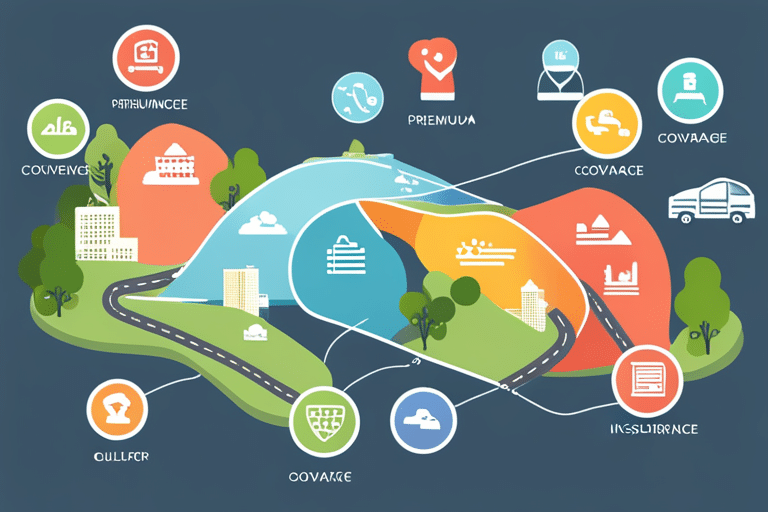Hey there, newbie! Buckle up because we’re about to take you on a wild ride through the world of auto insurance.
Don’t worry, we’ve got your back and we’re here to guide you every step of the way.
From understanding the basics to navigating those tricky claims, this beginner’s guide will make you an insurance whiz in no time.
So, put on your thinking cap and get ready to master the art of auto insurance like a pro!
Let’s hit the road together, shall we?
Key Takeaways
- Deductibles are the out-of-pocket amount before insurance coverage kicks in.
- Premiums are the monthly payments for auto insurance.
- Coverage limits determine the level of protection in case of accidents or damage.
- Factors such as driving record, age, and location determine auto insurance premiums.
Understanding the Basics of Auto Insurance

To understand the basics of auto insurance, you’ll need to familiarize yourself with terms like deductibles and premiums. But don’t worry, it’s not as complicated as it sounds! Think of auto insurance as your trusty sidekick that swoops in to save the day when life throws a curveball at your car.
Let’s start with deductibles. This is the amount of money you agree to pay out of pocket before your insurance kicks in. It’s like a ticket to enter the superhero club – once you’ve paid your deductible, your insurance company will swoop in and take care of the rest. Just remember, higher deductibles usually mean lower premiums (that’s insurance lingo for monthly payments).
Speaking of premiums, think of them as membership fees for being part of the superhero club. The amount you pay each month is determined by factors like your driving record, age, and even where you live. It’s important to find that sweet spot where your premium fits comfortably into your budget without leaving you eating ramen noodles every night.
Now that we’ve covered deductibles and premiums, let’s talk about determining coverage limits and understanding policy exclusions (cue dramatic music). Coverage limits are like safety nets – they determine how much protection you have if something goes wrong on the road. Policy exclusions are what insurance companies won’t cover because they’re considered too risky or outside the scope of normal wear and tear.
Determining the Right Coverage for Your Needs

Figuring out the right coverage for your needs can be a challenge, but it’s important to assess your specific circumstances. After all, you don’t want to end up with too little coverage and be left high and dry when an accident occurs. On the other hand, you also don’t want to overpay for coverage that you don’t really need. So how do you find that sweet spot?
Here are four steps to help you evaluate your insurance needs:
-
Take a good look at your car: Is it brand new or has it seen better days? The value of your vehicle will play a significant role in determining how much coverage you should get. If your car is older and not worth much, maybe comprehensive coverage isn’t necessary.
-
Consider your driving habits: Are you on the road constantly or do you only drive occasionally? If you spend a lot of time behind the wheel, getting higher liability limits might be a wise choice.
-
Evaluate your financial situation: If money is tight and adding more coverage would strain your budget, focus on meeting the minimum requirements set by law instead.
-
Think about potential risks: Do you live in an area prone to natural disasters or have a history of accidents? Understanding the risks associated with where and how often you drive can help guide your decision-making process.
Now that we’ve evaluated our insurance needs, let’s dive into exploring different types of auto insurance policies…
Exploring Different Types of Auto Insurance Policies

So, you’ve finally decided to dive into the world of auto insurance. Well, buckle up because we’re about to take a wild ride through the three key points you need to know:
-
Coverage and Limits: This is the foundation of any insurance policy. It refers to the types of protection you have and the maximum amount the insurance company will pay in the event of a claim. Understanding your coverage and limits is crucial to ensure you have the right level of protection for your needs.
-
Deductibles and Premiums: These are the financial aspects of your insurance policy. Your deductible is the amount you must pay out of pocket before your insurance kicks in, while your premium is the amount you pay regularly to maintain coverage. It’s important to find the right balance between a deductible you can afford and a premium that fits your budget.
-
Optional Add-Ons and Riders: These are additional coverages you can add to your policy for extra protection. Examples include roadside assistance, rental car coverage, and gap insurance. While these add-ons can provide valuable benefits, they also come at an additional cost. It’s essential to evaluate whether the added protection is worth the expense.
Trust me, by the end of this discussion, you’ll be an insurance guru ready to conquer any policy that comes your way!
Coverage and Limits
Understanding auto insurance coverage and limits is essential for responsible vehicle owners. It’s like knowing the secret handshake to enter the exclusive club of car ownership. So, let’s dive in and unravel the mysteries together!
Here are four things you need to know about coverage and limits:
-
Liability Coverage: This is your superhero cape that protects you if you cause an accident and someone gets hurt or their property gets damaged.
-
Comprehensive Coverage: Think of this as a bodyguard for your car against non-accident-related mishaps, like theft, vandalism, or a tree branch falling on it.
-
Property Damage Limit: This sets the maximum amount your insurance will pay if you damage someone else’s property.
-
Bodily Injury Limit: This determines the maximum amount your insurance will cover for injuries caused to others.
Now that we’ve got coverage covered (pun intended), let’s move on to deductibles and premiums where things get even more interesting!
[Transition sentence into next section]
But before we tackle deductibles and premiums, let’s first understand how they affect your auto insurance policy.
Deductibles and Premiums
Now that you’ve got a grasp on coverage and limits, let’s talk about how deductibles and premiums impact your auto insurance policy.
Think of deductibles as the ‘ouch’ factor in an accident. It’s the amount of money you have to pay out of pocket before your insurance kicks in. You have different deductible options, like low or high, depending on how much risk you’re willing to take.
But hold on, don’t forget about premiums! These are the monthly or annual payments you make to keep your policy active. When comparing premium rates, it’s essential to find that sweet spot between affordability and comprehensive coverage.
Optional Add-Ons and Riders
Let’s take a look at some optional add-ons and riders that can enhance your auto insurance policy. These coverage options are like the cherries on top of your policy sundae, adding an extra layer of protection and peace of mind. So buckle up and get ready for a wild ride through the world of policy enhancements!
-
Roadside Assistance: Picture this – you’re cruising down the highway, enjoying the wind in your hair when suddenly, pop! Your tire goes flat. With roadside assistance, you’ll have someone to rescue you from roadside disasters.
-
Rental Reimbursement: Accidents happen, but they don’t have to leave you stranded without wheels. Rental reimbursement will cover the cost of a rental car while yours is being repaired.
-
Gap Insurance: You just drove off the lot with your shiny new car when bam! It gets totaled in an accident. Gap insurance bridges the gap between what you owe on your loan or lease and what your car is worth.
-
Accident Forgiveness: We all make mistakes – hey, nobody’s perfect! Accident forgiveness means that if you have a little fender bender, it won’t cause your rates to skyrocket.
These optional add-ons and riders are like sprinkles on top of your auto insurance treat – they make it even sweeter! So go ahead and explore these coverage options to customize your policy according to your needs and preferences. Happy driving!
Factors That Affect Auto Insurance Premiums

To get the best auto insurance premium, you’ll need to consider factors such as your driving record, age, and the type of car you own. Let’s dive into these factors affecting premium rates and see how they can impact your wallet!
First up, let’s talk about your driving record. If you’ve got a squeaky clean record with no accidents or tickets, congratulations! Insurance companies love responsible drivers like yourself. But if you’re more prone to fender benders than a demolition derby driver, well, be prepared for higher premiums. So remember folks, drive safe and save cash!
Next on the list is age. Now I know getting older isn’t always fun (hello wrinkles!), but when it comes to auto insurance premiums, age can work in your favor. Younger drivers are often seen as riskier by insurance companies because of their lack of experience behind the wheel. So don’t worry if you’re still rocking that ‘new driver’ sticker on your bumper; just keep adding those candlesticks on your birthday cake and watch your premiums drop.
Last but not least is the type of car you own. Sorry folks, but that flashy sports car of yours might turn heads on the street, but it’ll also make insurance companies rub their hands together with glee. High-performance vehicles often come with high price tags for repairs and replacements in case of an accident.
So there you have it – the key factors that affect auto insurance premiums: driving record, age, and car type. Now that you understand how these factors play into determining your premium rates, let’s move on to some tips for saving money on auto insurance.
But before we start saving those dollars…
Tips for Saving Money on Auto Insurance

So, you want to save some money on your auto insurance, huh? Well, lucky for you, there are a couple of tricks up our sleeve that can help you do just that!
First off, have you considered bundling your coverage? Not only will it give you more protection, but it might also give your wallet a break.
And if you’re a safe driver (or at least claim to be), then get ready for some sweet discounts coming your way!
Bundling Coverage for Savings
By bundling your auto and home insurance, you can save money on your premiums. And who doesn’t love saving money? It’s like finding extra cash in the pocket of that old jacket you haven’t worn in years. So, why not take advantage of this opportunity to bundle up and keep some dollars in your wallet?
Here are four reasons why bundling coverage is a smart move:
-
Discount opportunities: When you bundle your policies, insurance companies often offer discounts as a way to reward your loyalty.
-
Convenience: Having all your coverage under one roof means less paperwork and fewer headaches when it comes to managing your policies.
-
Simplified billing: With bundled coverage, you only have one bill to worry about each month. It’s like having a personal assistant for your insurance needs!
-
Comparing rates made easy: Bundling allows you to compare rates from different insurers more easily since you’re looking at multiple policies at once.
Safe Driver Discounts
Safe driver discounts can help you save even more on your auto insurance premiums. Who doesn’t love a good discount, right? And when it comes to driving, being safe is always in style. So, buckle up and let’s dive into the world of safe driver discounts.
To be eligible for these sweet savings, you need to demonstrate some seriously safe driving habits. Check out this handy table to see if you meet the criteria:
| Safe Driving Habits | Discount Eligibility |
|---|---|
| No accidents in 5 years | 15% off |
| No speeding tickets in 3 years | 10% off |
| Completion of defensive driving course | 5% off |
| Installing a telematics device | Varies |
Now that you know what it takes to qualify for these discounts, let’s move on to the next step: choosing the right insurance provider.
How to Choose the Right Insurance Provider

When choosing the right insurance provider, you’ll want to consider factors such as coverage options and customer reviews. After all, you don’t want to end up with an insurance company that leaves you high and dry when you need them the most. So, here are some tips to help you make the best decision:
-
Comparing Quotes: Don’t settle for the first quote you receive! Take the time to shop around and compare prices from different insurance providers. You might be surprised at how much money you can save by doing a little research.
-
Researching Customer Reviews: It’s always a good idea to see what other people have to say about their experiences with a particular insurance provider. Look for reviews online or ask friends and family for recommendations. This will give you a better idea of how reliable and trustworthy they are.
-
Checking Coverage Options: Make sure the insurance provider offers the coverage options that are important to you. Whether it’s comprehensive coverage, roadside assistance, or rental car reimbursement, know what you need before making your decision.
-
Considering Customer Service: Dealing with insurance claims can be stressful enough without having to deal with unhelpful customer service representatives. Look for an insurance provider that has a reputation for excellent customer service and support.
By comparing quotes, researching customer reviews, checking coverage options, and considering customer service, you’ll be well on your way to finding the right insurance provider for your needs.
Now that we’ve covered how to choose the right insurance provider, let’s dive into another important aspect – navigating the claims process…
Navigating the Claims Process

So, you’ve unfortunately found yourself in a fender bender and now it’s time to navigate the treacherous waters of the claims process.
First things first, gather up all those pesky documents like police reports, photos of the accident scene, and any witness statements – because apparently your word alone isn’t enough these days.
Next up, get ready for a waiting game that could rival even the most intense round of Monopoly. The timeframe for claim resolution can vary from days to weeks (or even months if you’re really unlucky), so buckle up and prepare to practice your patience skills.
And finally, brace yourself for the infamous insurance adjuster – a creature known for their elusive nature and cryptic questions like ‘Tell me about the damage in excruciating detail.’ Just remember to stay calm, be honest (but not too honest), and don’t let their poker face intimidate you.
Good luck out there!
Required Documentation for Claims
If you’re filing a claim, make sure to bring all the required documentation. Trust me, you don’t want to be that person who shows up empty-handed and gets stuck in a never-ending paperwork nightmare.
So, here’s a handy-dandy list of what you need:
-
Accident Report: This is like the golden ticket that proves your claim is legit.
-
Photos/Videos: A picture is worth a thousand words, especially when it comes to documenting the damage.
-
Witness Statements: Get those eyewitness accounts locked down before they disappear into thin air.
-
Medical Records: If you’ve suffered any injuries, it’s time to whip out those doctor’s notes.
Timeframe for Claim Resolution
Alright, buckle up because we’re diving into the wild world of claim resolutions! Now that you’ve got all your ducks in a row with the required documentation, let’s talk about how long it takes to get your precious claim sorted out.
Picture this: you’re anxiously waiting for your insurance company to swoop in and save the day. But how long does it actually take? Well, my friend, it can vary. Some claims are resolved quicker than a cheetah chasing its lunch, while others take longer than a sloth on a Sunday stroll.
To give you an idea of what to expect, here’s a nifty little table showcasing the average claim amount and the impact previous claims have on future premiums:
| Average Claim Amount | Impact on Future Premiums |
|---|---|
| Low | Barely noticeable |
| Medium | Slightly higher |
| High | Hold onto your wallet |
Dealing With Insurance Adjusters
Dealing with insurance adjusters can be a bit intimidating, but remember that they’re there to help you through the claims process. So, take a deep breath and let’s tackle this challenge together!
Here’s how to handle those insurance adjusters like a pro:
-
Be prepared: Gather all necessary documents and information before speaking with an adjuster. Knowledge is power!
-
Stay calm and confident: Remember, you’re in control of the conversation. Don’t let their fancy jargon intimidate you.
-
Negotiate wisely: Don’t settle for less than what you deserve. Be assertive but fair when negotiating settlements.
-
Handle disputes professionally: If your claim gets disputed, gather evidence and present your case calmly and logically.
Now that you know how to deal with those adjusters, let’s dive into understanding auto insurance terminology in the next section. It’ll make navigating this world even easier!
Understanding Auto Insurance Terminology

To better understand auto insurance, you should familiarize yourself with common terms such as deductible and premium. Now, I know what you’re thinking – those words sound like something out of a complicated legal document or a secret code for insurance agents. But fear not! I’m here to break it down for you in a way that even your grandmother would understand.
Let’s start with the deductible. Think of it like the entrance fee to the world of auto insurance claims. When you have an accident and need to make a claim, this is the amount of money you have to pay out of pocket before your insurance kicks in. It’s like buying tickets to a concert – you gotta pay upfront before you can enjoy the show.
Next up is the premium. This is basically your monthly membership fee for being part of the auto insurance club. The higher your premium, the more coverage options you have. It’s like joining an exclusive gym – sure, it costs more, but you get access to all the fancy equipment and classes.
Now that we’ve tackled those two biggies, let’s move on to understanding coverage options. This is where things can get a little tricky, so bear with me. Coverage options are like toppings on a pizza – they come in different flavors and combinations. You’ve got liability coverage (the plain cheese), collision coverage (the pepperoni), comprehensive coverage (the works), and so on.
Common Auto Insurance Myths Debunked

Don’t let common auto insurance myths confuse you – understanding the truth behind them can help you make informed decisions about your coverage. So, buckle up and get ready to dispel some misconceptions! Here are four debunked auto insurance myths that will have you feeling like a master of coverage options in no time:
-
Myth: Red cars pay higher premiums.
Truth: Sorry speed racers, but the color of your car doesn’t affect your premium. The factors that insurers consider are more about the make, model, year, and driving record. So go ahead and paint your car any color of the rainbow! -
Myth: Your credit score doesn’t matter for auto insurance.
Truth: Au contraire! Insurance companies often use credit scores to determine rates because they believe there is a correlation between good credit and responsible driving. So keep those bills paid on time if you want to save some green. -
Myth: Full coverage means everything is covered.
Truth: While ‘full coverage’ sounds like it covers everything from fender benders to alien abductions, it actually only refers to comprehensive and collision coverage. It’s important to understand the specific limits and exclusions in your policy. -
Myth: Your rates won’t increase if an accident isn’t your fault.
Truth: Unfortunately, even if you’re as innocent as a fluffy bunny in a field of daisies, being involved in an accident can still increase your rates. Insurers consider other factors such as claim history when determining premiums.
Now that these common myths have been debunked, you can confidently navigate the world of auto insurance with mastery! Remember to always read the fine print and ask questions when choosing or updating your coverage options. Safe travels!
Staying Informed and Making Informed Decisions

Staying informed about the truth behind auto insurance myths can help you make confident and well-informed decisions about your coverage. It’s like having a secret weapon in your back pocket, ready to protect you from any unexpected surprises. So, let’s dive into the world of auto insurance and debunk some common misconceptions.
But before we do that, let me present you with a handy-dandy table that will guide you through your journey of researching different insurance providers. After all, knowledge is power, right?
| Myth | Truth |
|---|---|
| Red cars cost more to insure | The color of your car has no impact on your premium |
| Older drivers pay more for insurance | Age is just a number, as long as your driving record is clean |
| Insurance covers everything in an accident | Nope! There are deductibles and limitations to consider |
| Your credit score doesn’t affect your rates | Sorry folks, bad credit can lead to higher premiums |
| You only need minimum coverage | Don’t skimp on coverage; it could leave you high and dry |
Now that we’ve debunked these myths together, it’s time for you to take charge and start researching different insurance providers. Remember to gather all the necessary information – compare quotes, read customer reviews, and don’t be afraid to ask questions.
Frequently Asked Questions
How Does My Credit Score Affect My Auto Insurance Premiums?
Hey, did you know that your credit score can actually impact how much you pay for auto insurance? Crazy, right? But don’t worry, there are strategies to improve it and lower those premiums!
Can I Cancel My Auto Insurance Policy at Any Time?
Sure, you can cancel your auto insurance policy at any time. Just remember the cancellation process and the consequences of cancelling. It’s like breaking up with your insurance company, but without the emotional baggage.
What Happens if I Lend My Car to Someone and They Get Into an Accident?
So, you lend your car to someone and they get into an accident. Well, buckle up! There are liability and legal implications to consider. Good thing auto insurance usually covers borrowed vehicles. Phew!
Will My Auto Insurance Cover a Rental Car if My Car Is Being Repaired?
Sure! If your car needs repairs and you have rental car reimbursement coverage, your auto insurance may cover the cost of a rental while your car is in the shop. Check your coverage limits to be sure!
Is It Possible to Have Multiple Auto Insurance Policies for the Same Vehicle?
Sure, you can totally have multiple auto insurance policies for the same vehicle. But before you go all insurance crazy, weigh the pros and cons and make sure you choose the right coverage for your wheels.
Conclusion
Congratulations, you’ve made it to the end of our beginner’s guide to navigating the world of auto insurance! By now, you should have a solid foundation of knowledge on understanding the basics, determining the right coverage for your needs, exploring different types of policies, and even debunking common myths.
But here’s a mind-blowing statistic for you: did you know that an estimated 20% of drivers on the road are uninsured? That means there’s a one in five chance that if you get into an accident, you’ll be dealing with an irresponsible driver who doesn’t have insurance to cover your damages. Yikes!
So make sure you protect yourself and your vehicle by having adequate coverage. Stay informed and drive safe!

